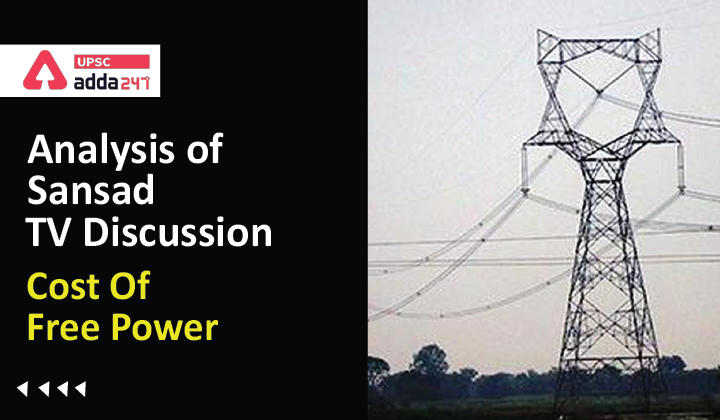Table of Contents
Analysis of Sansad TV Discussion: ‘Cost of Free Power’
”GS 2: Government Policies & Interventions”
Introduction
- Ongoing assembly elections in five states have seen a flurry of promises from political parties and the prominent one amongst these is the promise of free or subsidised power for farmers and domestic consumers.
- Though Good power supply and service are necessary to improve quality of life and encourage productive activities.
- This in turn requires financially stable distribution companies and accountability measures for quality service for all, especially small and rural consumers.
What Do Data say?
- Uttar Pradesh has 5 state discoms and amongst them, Paschimanchal Vidyut Vitran Nigam and Dakshinanchal Vidyut Vitran Nigam have the highest share of Agri consumers at close to 20%.
- Free power is already being provided for consumption up to 200 units/month in Delhi and Punjab.
- Due to free power in Delhi, the total state subsidy amounts to 11% of the total expenses.
- In Punjab, agri-linked consumers account for 24% of total consumers.
- According to an analysis free power to farmers account for 70% of total subsidies, free power to Scheduled Caste, backward caste and BPL families contribute 14 per cent while subsidised power to industrial consumers constitutes 16% of total subsidies.
Problems associated with subsidised electricity supply to agriculture
- Supported by state subsidy, electricity tariff to agriculture is low in most States – often less than ₹1/unit – and is free in some States such as Punjab, Tamil Nadu and Karnataka.
- While this helps in ensuring food security and promoting rural livelihood, free power has many adverse impacts.
- There is an inefficient use of electricity and water, neglect of service quality by the distribution companies leading to frequent outages and motor burnouts, and a high subsidy burden on the State governments.
- Free power provision along with issues of metering make the implementation of Direct Benefit Transfer difficult. All this leaves farmers, distribution companies and State governments frustrated.
- Roof-top solar and energy efficiency are good environment-friendly options for homes but providing free power to well-off households will discourage them from taking these up.
- The familiar, tragic story of free or low-tariff agriculture supply is going to play out in this segment too, with poor consumers becoming the ultimate losers.
Do We Need Power Subsidy?
- Providing subsidised low tariffs for small consumers is necessary, considering the rising costs of the electricity supply. The current cost is around ₹7-8/unit, which is not affordable for many small households.
- Free or low-tariff power is at best a short-term relief, which should be provided to those who desperately need it.
- A government which has the long-term interest of the people in mind should work to limit free power beneficiaries.
What Should be Done?
- A fixed rebate of up to ₹200/month for residential consumers can be provided in the electricity bill.
- The impact on small consumers will be significant, compared to big. As the rebate is delinked from consumption, distribution companies won’t have an incentive to inflate consumption.
- A similar rebate can be extended to home-based enterprises, which in most States pay high tariffs.
- There can be additional rebates for adopting energy-efficient appliances like refrigerators, combined with State-level bulk procurement programmes to reduce the cost.
- The atmosphere of mutual mistrust between small consumers and distribution companies has to change.
- There should be a quick resolution of arrears and one-time offers for settlements.
- If a bill amounts to more than three times that of previous bills, the distribution company should resolve it, without waiting for complaints.
- People question the wisdom of broad-brush promises such as free power, which cannot be sustained in the long run.
Conclusion
Free power not only erodes the financial viability of the electricity distribution sector but also leads to industrial and commercial consumers paying cross-subsidy in terms of higher power tariffs to partly compensate the under-recoveries discoms suffer on account of providing power at cheaper rates to domestic and agricultural consumers. So, the policy of freebies should be stopped by all political parties and there should be stringent laws on this.



 TSPSC Group 1 Question Paper 2024, Downl...
TSPSC Group 1 Question Paper 2024, Downl...
 TSPSC Group 1 Answer key 2024 Out, Downl...
TSPSC Group 1 Answer key 2024 Out, Downl...
 UPSC Prelims 2024 Question Paper, Downlo...
UPSC Prelims 2024 Question Paper, Downlo...
